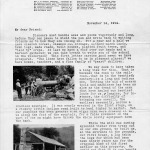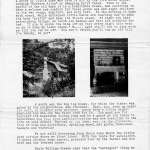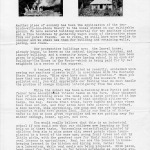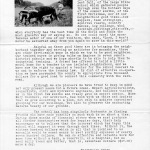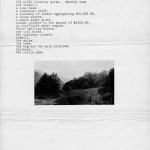Pine Mountain Settlement School
Series 17: PUBLICATIONS – – Publicity and Fundraising
“DEAR FRIEND” LETTERS November 14, 1914
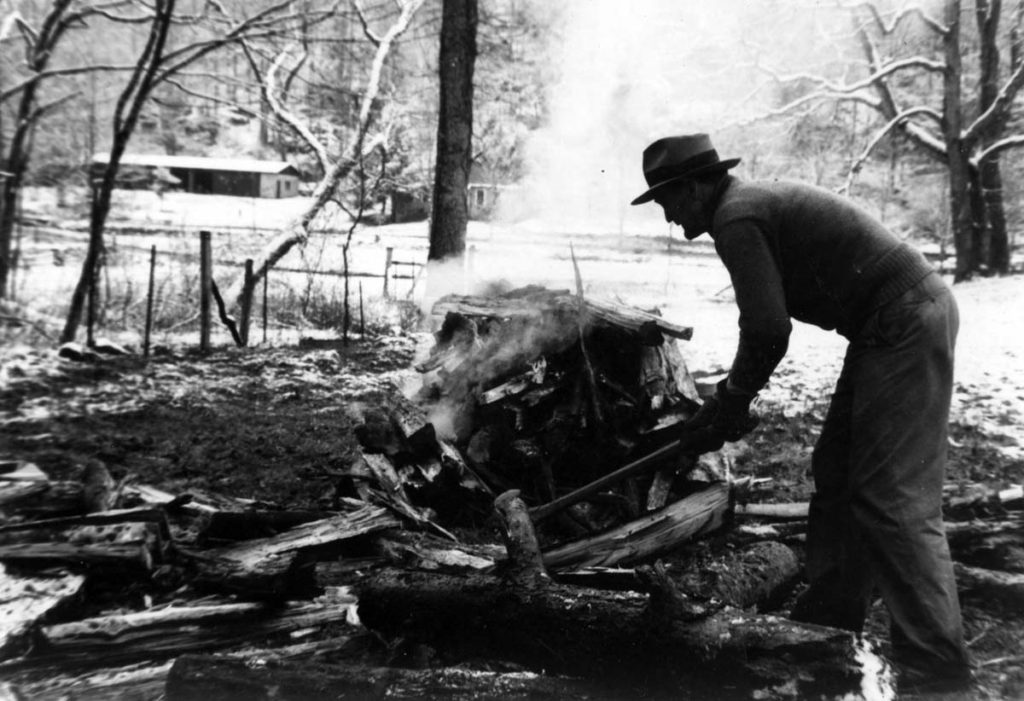
Burning brush. VII 63 Life Work Maintenance, Farm, Grounds. B-1919. [VII_63_life_work_001-10]
TAGS: Dear Friend letters, road problems, sawmill, Old Log, Big Log, Uncle John Shell, lime-making, stone-work, toolhouse, Laurel House, House in the Woods, sewage disposal, farm tasks, neighborhood events, hygiene talks, Mary Rockwell Hook, donors, fundraising, finances
DEAR FRIEND LETTERS 1914 November 14
CONTENTS: November 14, 1914, pages 1 – 5
Letterhead lists Executive Committee members, Treasurer, and General Advisory Board ; accomplishments in 1 1/2 years ; difficulties using road to the railroad ; bringing sawmill across mountain ; first house was built, re-using 90-year-old logs ; describes “pioneer” style interior and boarding children ; Big Log house built a month ago ; describes home-like interior, combining the new and the traditional ; workers live in Uncle John Shell’s cottage and two tents ; lime-making ; use of stones on the land for two sanitary closets and toolhouse ; Laurel House begun ; planning a community house ; school in open-air House in the Woods ; handling sewage disposal ; describes farm tasks ; children learn as they work ; lists neighborhood get-togethers ; hygiene talks by trained nurse ; county to appropriate $5000 for road ; experts visited and gave advice, including Mary Rockwell [Hook], architect ; donors have helped meet monthly expenses of nearly $700 ; need $17.00 more a day ; list of liabilities and assets
TRANSCRIPTION: DEAR FRIEND LETTERS 1914 November 14
Page 1 [dear_friend_1914_11_001.jpg]
[letterhead, listing Executive Committee members, Treasurer, and General Advisory Board]
November 14, 1914
My dear Friend:
Pioneers must handle axes and plows vigorously and long, before they can pause to wield the pen and write back to waiting friends as to how they are coming on. For a year and a half we have cleared forest, cleaned out streams, ditched marsh lands, hewn logs, made roads, built houses, planted fruit trees, and “laid by” crops. At last we have a roof over our heads and a harvest gathered; we can take breath to write you of the school in the wilderness! This first letter carries good news: we have prospered. “The lines have fallen to us in pleasant places;” we have homes, teachers, and a fine family of “peart” children.
We may seem to have taken a long time for this. That is because the road to the railroad — that is to the twentieth century — is a long and tedious one. Getting the aid of modern tools and machinery has been as slow as the tread of the oxen that have hauled our heaviest loads for us. Imagine, for instance, the difficulty of bringing our sawmill, the earliest necessity, across a roadless mountain. It was nearly wrecked in the first stage, on a rickety little incline road built to haul timber to market. Yet our suspense was even greater when eight oxen were drawing it to us along the foot of the mountain, for a false movement on the part of one ox might have thrown the whole costly equipment down the bank.
While the mill was sawing splendid timber from trees cut on our own ground, we built us, at the entrance to the grounds, our first house, a log cabin, the logs for which have been hewn ninety years ago for the original home of the first settler on this property. We could not find it in our hearts to destroy the ancient landmarks, so we hewed a few new logs and rebuilt the house.
Page 2 [dear_friend_1914_11_002.jpg]
-2-
With its wide porch, fireplace, and charming low-ceiled rooms, it preserves the cheerful homeliness of pioneer days. We have gathered into it not only the homespun covers, quaint bedspreads, hand-wrought andirons, the hunter’s gun and pouch of the past, but a group of little boys who love to sit by the fire after supper singing “Barbara Allen” or swapping ha’nt tales. True to the spirit of the old days it is a hospitable house, and contrives to have a welcome and comfort for three grown ups and eight children in its two rooms, dog-trot, and airy loft. In the morning it hums with sound, while untrained little hands are learning how to make its beds “pretty” and keep its floors clean. At night you hear astonishing things, as teeth are washed and feet are scrubbed for bed. “I aim to scrub the hid off my feet every night this week so as to keep my towel clean.” W—, aged six, “I aim to stay with ye till you run me off. You don’t reckon you’ll run me off till I’m twenty, do ye?”
A month ago the Big Log house, for which the timber was given by the neighborhood, was finished. That, too, even up under its roof, is crowded with children, among them a little eight-year-old boy who cut the first tree for it. You must see for yourself its beautiful living room and be a guest at its table to understand how free from institutionalism and how home-like is the life of this school. Typical of its aims, too, is the juxtaposition of loom and dictionary, spinning wheel and globe, home-made baskets and victrola!
We are still borrowing from Uncle John Shell the little grey cottage where we first lived. With two tents for satellites, it makes another home center, presided over by the farmer and his wife and our trained nurse.
Uncle William Creech says that the “savingest” thing we have done is to burn our own lime for farm and building purposes.
Page 3 [dear_friend_1914_11_003.jpg]
-3-
Another piece of economy has been the application of the two-birds-with-one-stone theory to the loose stones on our cultivable ground. We have secured building material for two sanitary closets and a fine toolhouse by gathering wagon loads of obstructive stone from our potato fields. As to rocks, we still have more worlds to conquer and we shall use them for building and retaining walls, paving, and roads.
Our prospective buildings are: the Laurel House, already begun, to serve as the central dining-room, kitchen, and laundry building; and a community house, for which money has been given or pledged. At present we are having school in an open air building — The House in the Woods — which is being paid for by our neighbors in a series of box suppers.
A trained nurse, who visited us recently, exclaimed upon seeing our sanitary closets built in accordance with the Kentucky State Board plans, “Mine eyes have seen thy salvation.” When you know that one person in two in this county has hookworm from polluted soil, you will appreciate our feeling that we must handle the problem of sewage disposal intelligently from the start.
While the school has been a-building Miss Pettit and our farmer have accomplished titanic tasks on the farm. Four thousand feet of box-ditching drain the land, and a large portion of it has been fenced away from the efforts of that intrepid citizen-at-large, the hog. Beside fruit trees, berry bushes and grape vines have been set out, and four acres have been cleared for orchard. A disc harrow, lime sprinkling, cow peas and rye are turning neglected fields into garden land. Daily our family of thirty-three is fed on homegrown vegetables and we are putting away for winter cabbage, beans, apples, and corn.
You would really believe that this is an industrial school if you could see what our children are learning as they help us in these tasks. Watermelons scientifically planted by children from six to nine years old; sweet potato vines transplanted by a brood of the same age; young fruit trees set out by little girls, with the greatest care for their roots: these are real lessons in agriculture. Real too are the lessons in housekeeping learned in the kitchen and dining room, rather than in a laboratory, while real meals are being prepared. Milk pails, kept sweet for family use go far beyond notebooks as concrete evidences of accomplishment.
Page 4 [dear_friend_1914_11_004.jpg]
-4-
There is no space to tell you of the hookworm clinic nor the farmers’ institute held last fall, of the large Bible school which gathered people through even the hottest days of the summer months, of the first Christmas, nor of our neighborhood good times — box suppers, bean stringings, squirrel roasts, country dances, log rollings, wool pickings, quiltings, stir-offs, — when everybody has the best time in the world and finds the most graceful way of saying so. No one could excel the spontaneous ardor of one of our visitors, who said, “Lord, I won’t never be satisfied away from you again no more in this world!”
Helpful as these good times are in bringing the neighborhood together and serving as antidotes for moonshine, there are other serviceable ways in which we try to be good neighbors. Our trained nurse is giving talks on hygiene in seven remote district schools and we hope shortly to be able to help them to industrial training. A friend has offered to build a little model home for a teacher in one isolated neighborhood, and we have now the right to appoint a teacher for the school nearest to us and to enforce the truancy law. By dint of effective co-operation we have persuaded the county to appropriate five thousand dollars for a good road to connect this community with the railroad.
Although we are pioneers we have tried to keep in mind not only present needs but a future ideal. Expert agriculturalists, orchardists, civil and hydraulic engineers, and builders visited us in the first few months and freely gave us expert advice. Miss Mary Rockwell, our architect, has been with us twice and insists that we grow according to a plan, not only to achieve convenient grouping for our buildings, but also to preserve the enchanting natural beauty of our grounds.
The school has been singularly fortunate in finding friends who have made possible so much work in so short a time. During these months of financial stress when we must postpone all further constructive work for happier days, their help encourages us to believe that the interest which has begun this school will support it even through dark times. Without it, the sixteen hundred dollars which is all that is promised to us annually would be scant means to meet monthly expenses of nearly seven hundred dollars. We can do effective and valuable work for some time without a barn, a reservoir, or a hospital, but we need daily bread and butter, that is, seventeen dollars ($17.00) more a day.
Faithfully yours,
[signed] Ethel de Long
Page 5. [dear_friend_1914_11_005]
-5-
Liabilities.
$700.00 a month.
Assets.
The original 234 acres of land.
125 acres recently given. (Mostly coal and timber.)
A coal bank.
A limestone cliff.
A boundary of timber aggregating 600,000 ft.
a stone quarry.
a maple sugar grove.
Annual pledges to the amount of $1600.00.
An unpolluted water supply.
Three dwelling houses.
One tool house.
Two sanitary closets.
Sawmill.
Two mules.
Two cows.
one hog and two more promised.
Chickens.
Two collie pups.
GALLERY: DEAR FRIEND LETTERS 1914 November 14
- 01 Dear Friend Letter, November 14, 1914, page 1. dear_friend_1914_11_001.jpg
- 02 Dear Friend Letter, November 14, 1914, page 2. dear_friend_1914_11_001.jpg
- 03 Dear Friend Letter, November 14, 1914, page 3. [dear_friend_1914_11_003.jpg
- 04 Dear Friend Letter, November 14, 1914, page 4. dear_friend_1914_11_004.jpg
- 05 Dear Friend Letter, November 14, 1914, page 5. dear_friend_1914_11_005.jpg
See Also:
DEAR FRIEND LETTERS 1914 January 2
Return To:
DEAR FRIEND LETTERS Index

